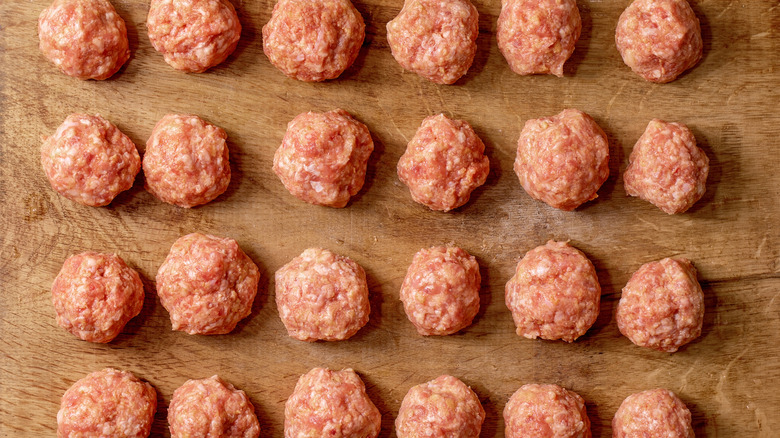Gordon Ramsay's Key To Top Tier Meatballs Lies In Their Texture
We know: Everyone's elderly relative/long-time family friend/Victorian ghost has "The Best Ever Meatball Recipe," ideally written in curly script on a weathered old index card. And sure, the meatballs are probably great! Those comforting classics are unrivaled at capturing nostalgic flavors or even just unexpected ingredients curiously kept in the mix for generations (it's almost always raisins, but things like oats can be added to meatballs, too). But sometimes, as a home cook-scientist, it's best to recalibrate your baseline and refresh your notion of what the archetypal meatball should be. Celebrity chef, restaurateur, and insult comic Gordon Ramsay, who is flush in cooking tips, has suggestions for making meatballs that could spur that very reset.
When it comes to judging meatball quality, Ramsay deems consistency a critical feature. "For me, a good meatball is all about the softness, the texture, that rich beef and the way it sort of melts in your mouth," he says in an instructional video on YouTube, adding, "You can color it on the outside, but you want it nice and soft, and sort of rich in the center." As he showcases in his recipe, Ramsay prepares his (mostly standard) ingredients using some easily replicated modifications intended to keep the meatballs especially moist.
Gordon Ramsay's secret to making soft meatballs
Now, following in the footsteps of culinary great Gordon Ramsay, you're obviously going to gather all of your meatball ingredients ahead of time, adopting the practice of mise en place, one of Julia Child's cooking tips. For the most part, the components are what you might expect: a mix of beef and pork, seasonings, finely chopped onions, and thinly sliced garlic. But, in a mild divergence from the eggs many use to bind their meatballs, this preparation eschews that standard meatball ingredient in lieu of another familiar one, just applied a little differently.
According to Ramsay's method, a mixture of bread crumbs and milk not only stands in as that typical food glue, it also aids with achieving softness in the finished meatballs. Bread crumbs alone, of course, are naturally dry and rough. They obviously break down throughout the whole cooking process, but combining them with milk begins to dissolve them, expediting that textural change and keeping everything supple from the start. From there, form those babies into golf ball-sized spheres (anything smaller will be liable to dry out; anything larger won't cook evenly), give them about 15 minutes on the stovetop, and you should end up with soft meatballs that would (hopefully) meet with Ramsay's rare approval.

